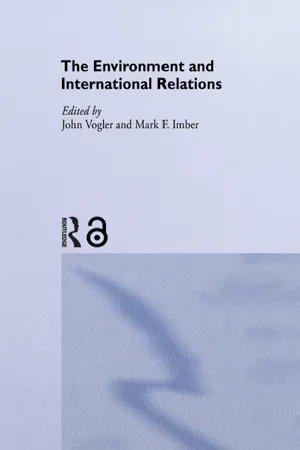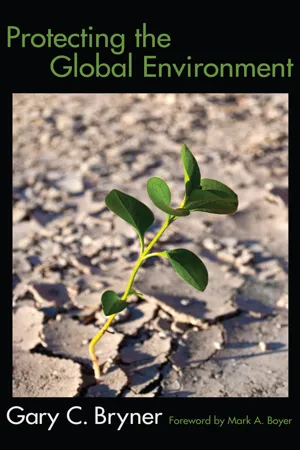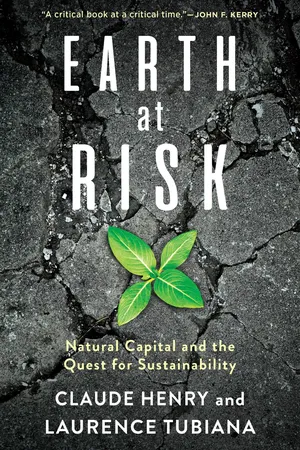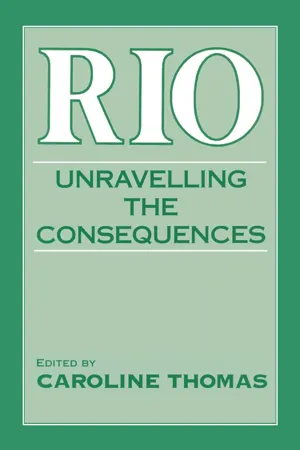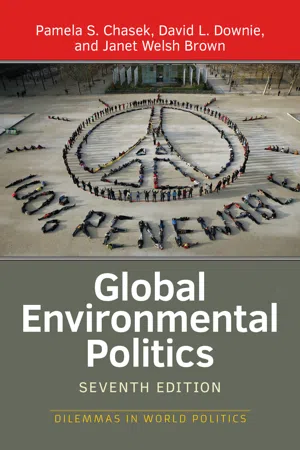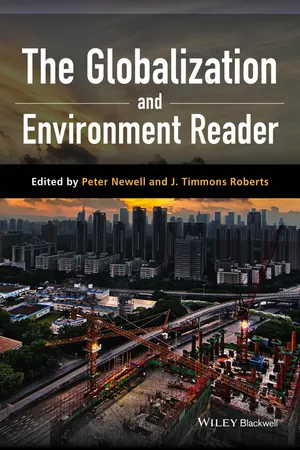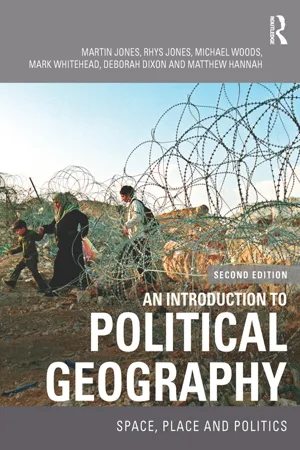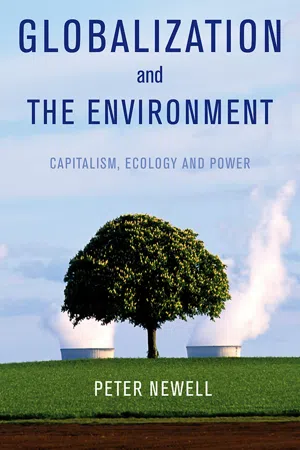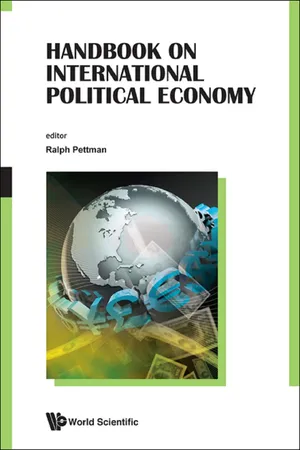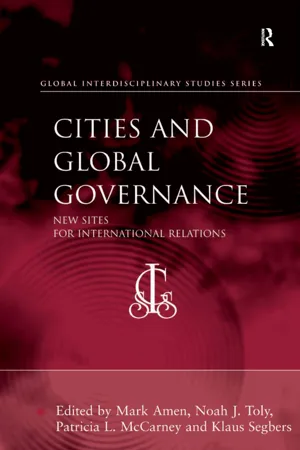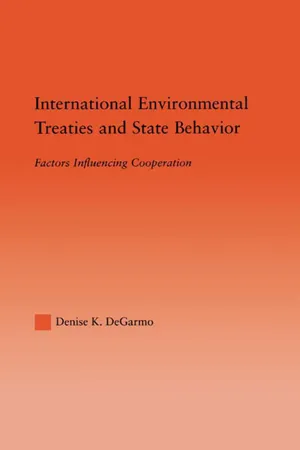Politics & International Relations
Globalisation and the Environment
Globalization and the environment refer to the interconnectedness of economic, social, and environmental systems on a global scale. It involves the impact of global economic activities, trade, and technological advancements on the natural environment, including issues such as climate change, biodiversity loss, and resource depletion. This relationship raises questions about sustainability, environmental justice, and the need for global cooperation to address environmental challenges.
Written by Perlego with AI-assistance
Related key terms
11 Key excerpts on "Globalisation and the Environment"
- eBook - ePub
- Mark Imber, John Vogler, Mark Imber, John Vogler(Authors)
- 2005(Publication Date)
- Routledge(Publisher)
fait accompli . The misrecognition of environmental concerns is now remedied through an approach which attempts to bring the environment into international relations. Such an approach is inherently limited, however, because it fails to account for the previous exclusion. Studying the political economy of the environment necessitates an attempt to understand why environmental issues had been hitherto neglected. That is, a past failure to include environmental concerns in the discipline cannot simply be regarded as a fact with no implications for the theorisation of the global system. Accelerated environmental degradation raises crucial questions concerning humanity’s relationship with the natural world, and with other species. Analyses of the global ecological crisis therefore require a rethinking of fundamental concepts and assumptions. Unless international relations theory sets out explicitly to tackle the set of questions which arise from the interaction between the economy and the ecosystem, it will instead merely find itself co-opting environmental analysis and accommodating ‘green’ issues within the prevailing conception of international relations. It is not in fact the case that international relations theory had previously ignored environmental issues altogether, but rather that (like all social sciences) by internalising environmental issues, it had rendered them invisible. International relations theory had traditionally removed from critical view the ways in which, historically, environmental issues had been silenced.The crucial question now becomes: how is the new-found visibility to be articulated? And it is important, indeed, to recognise which approaches will provide the best starting point for assessing the politics and economics of global environmental degradation. Before examining the contribution of IPE, it is necessary to look at the manner in which conventional international-relations theory has approached this task of assessment. - eBook - ePub
- Gary C Bryner(Author)
- 2015(Publication Date)
- Routledge(Publisher)
NDERSTANDING GLOBAL ENVIRONMENTAL POLITICS Theories of International Relations and Political ScienceT here is broad and deep agreement among environmental scientists that climate change, water shortages, and loss of biodiversity combine with other global environmental problems to threaten the future of humankind. They point out that droughts and other extreme weather events, declining fisheries, emerging diseases, and inadequate food production are some of the results of these crises. The evidence of environmental harms is clear, and there is widespread consensus among ecologists that risks are increasing. Yet that scientific knowledge has not resulted in thorough policy responses. This chapter examines the political and behavioral factors that have kept us from developing effective responses to global environmental threats. This means asking why we have been so unwilling to address threats to our well-being, especially as taking timely action seems so clearly in our self-interest.One way to think about these challenges is to lay them out on a continuum. At one end are environmental consequences that can be managed under existing institutions of government; the task at this end is to continue with existing efforts and expand these efforts incrementally to meet new problems. International relations (IR) theories are best suited to address these kinds of consequences, but unfortunately, there is little agreement that consequences will be so limited. At the midpoint in the continuum are consequences that require major changes in the policy-making capacity. These involve creating the ability to bring about needed changes in the way people in the wealthy world consume resources and to foster a type of development in poor countries that dramatically increases their peoples’ well-being without also increasing their environmental impacts. At the other end of the continuum, environmental changes are likely to be chaotic, unpredictable, and catastrophic. IR theory is not well suited to suggesting how far-reaching changes in policy capacity can be fostered, and it has few resources for understanding human behavior in the face of catastrophic environmental change. - eBook - ePub
Earth at Risk
Natural Capital and the Quest for Sustainability
- Claude Henry, Laurence Tubiana(Authors)
- 2017(Publication Date)
- Columbia University Press(Publisher)
11 THE GEOPOLITICS OF ENVIRONMENT A G2 MODEL BETWEEN THE UNITED STATES AND CHINAAs illustrated in chapter 10 , the global environmental question is a fundamental question of international relations, while simultaneously being regularly sidelined within the global agenda. As such, environmental governance is inherently linked to the question of sovereignty: although global environmental governance has been reappropriated by intrastate levels (local authorities such as cities, but also regions and federated states) and by nonstate players from influence networks and actors of participatory democracy (such as civil society, associations, NGOs, and businesses), it persists in being dominated by the state. Indeed, the state remains preeminent in the framing and shaping of collective action (Lerin and Tubiana 2005; Tubiana and Voituriez 2007). The presuppositions from the 1990s—that is, that state levels would be marginalized in the future regulation of global issues—are disclaimed today by the resistance (if not the reaffirmation) of the ultimate sovereignty of states in deciding their own development path.1 - eBook - ePub
Rio
Unravelling the Consequences
- Caroline Thomas(Author)
- 2014(Publication Date)
- Routledge(Publisher)
1992 ] for examples from international relations). In this article I examine whether the seeming centrality of environmental concerns is not in fact mistaken by reference to two dimensions of the role of environmental politics: within international relations as practice, and within the academic subject of international relations. I argue that there are powerful reasons, essentially political, that may keep the environment on the periphery in each setting.Such a view may well seem heretical to those who work within the environmental politics area. However, my overall claim is that too often practitioners and academics alike fall into the trap of being drawn by the ethical, moral or even common-sense logic of their argument or position without sufficient attention being paid to the ‘realities’ of political and economic power. As someone who works in probably the most conservative academic discipline, one which reifies the state as the centre-piece of political and economic analysis, I want to put forward a set of reasons why environmental politics may be destined to stay on the periphery of international relations (and of the discipline of international relations).Perhaps an historical precedent is to be found in the politics and study of European integration. In the 1950s and early 1960s, the logic of integration as a practice and as an (often interrelated) academic field, forecast the end of the states-system. Whether by functional stealth or by neo-functional co-option the state was to be overtaken by other actors. Arguably a similar neglect of high politics is present in most contemporary environmental work as was present in the heady days of European integration. Moreover, the states-system has faced many challenges before, and since, that posed by European integration. Yet for all its faults, and crucially for all its constraining and silencing of alternative notions of political community, the states-system remains the dominant political structure of international relations. - eBook - ePub
- Pamela S. Chasek(Author)
- 2018(Publication Date)
- Routledge(Publisher)
1 The Emergence of Global Environmental PoliticsUntil the 1980s, most governments regarded global environmental problems as minor issues, marginal both to their core national interests and to international politics in general. Then the rise of environmental movements in industrialized countries and the appearance of well-publicized global environmental threats that affect the welfare of all humankind—such as ozone layer depletion, climate change, and dangerous declines in the world’s fisheries—awarded global environmental issues a much higher status in world politics. Today, environmental issues are globally important both in their own right and because they affect other aspects of world politics, including economic development, trade, humanitarian action, social policy, and even security.Global concern about the environment evolved in response to expanded scientific understanding of humanity’s increasing impact on the biosphere, including the atmosphere, oceans, forests, soil cover, and a large number of animal and plant species. Many by-products of economic growth—such as the burning of fossil fuels, air and water pollution, hazardous waste, release of substances that destroy stratospheric ozone, production of toxic chemicals, increased use of natural resources, and decreasing forest cover—put cumulative stresses on the physical environment that now threaten human health and economic well-being. The realization that environmental threats have serious socioeconomic and human costs and that unilateral actions by individual countries cannot solve these problems produced increased international cooperation aimed at halting or reversing environmental degradation.This chapter provides an introduction to global environmental politics. It highlights key economic and environmental trends, introduces and defines important concepts, and traces some of the major intellectual currents and political developments that have contributed to the evolution of global environmental politics. - eBook - ePub
- Pete Newell, J. Timmons Roberts, Peter Newell, J. Timmons Roberts(Authors)
- 2016(Publication Date)
- Wiley-Blackwell(Publisher)
Part III Explaining the Relationship between Globalization and the Environment Introduction This section brings together four pieces that set out to explain how globalization is affecting the environment. The first by Clapp and Dauvergne lays out a framework of four ways of looking at environmental problems, and the following pieces are examples of those approaches. The World Bank chapter exhibits a market environmentalist position on how to solve the problem. The Newell piece includes political economy and political ecology in what can be seen as a “social green” approach to globalization and the environment. Finally the Levy, Haas, and Keohane piece provides a classic “institutionalist” approach to solving global environmental issues. The issues covered in the pieces are diverse, and reveal quite different proposals of ways forward. In their widely used teaching book on global environmental politics Paths to a Green World, Jennifer Clapp and Peter Dauvergne outline a series of different approaches or worldviews regarding the relationship between globalization and the environment. The framework places scholars, policy-makers, bureaucrats, business people and activists who consider themselves environmentalists into four categories. Their categorization is based on each group’s beliefs about the roots of environmental problems, on their sense of whether the Earth is fragile or resilient, and whether they think governments, firms, or individuals are the most likely to contribute to solving the problems. Market liberal environmentalists – who we heard from in the last section – acknowledge failures of the economic system to include ecological impacts, and believe that pricing pollution or establishing trading systems provide the best ways of managing them. By ‘internalizing’ environmental costs, their true value gets factored into decisions about production and investment - eBook - ePub
An Introduction to Political Geography
Space, Place and Politics
- Martin Jones, Rhys Jones, Michael Woods, Mark Whitehead, Deborah Dixon, Matthew Hannah(Authors)
- 2014(Publication Date)
- Routledge(Publisher)
10Political geography and the environmentIntroduction: what are environmental politics anyway?Can I (Mark Whitehead) let you into a little secret? This is, perhaps, not the best secret for someone writing a chapter on the form and nature of environmental politics to admit, but I must confess to finding it very difficult to effectively define and/or discern where environmental politics begins and other manifestations of political life end. What I can say with some certainty is that this definitional difficulty I experience is not a product of a lack of effort. I teach lecture courses, write newspaper articles, convene seminars, and regularly blog and micro-blog on environmental politics. But the more I think about, talk on and practise what I believe to be environmental politics, this elusive phenomenon (or more accurately collection of phenomena) appears to slip my grasp.My problem does not derive from the fact there are no clear definitions of what environmental politics is all about. For many, environmental politics is synonymous with environmentalism: that collection of interconnected political movements that first started to emerge in the eighteenth and nineteenth centuries. While there are various shades and strengths of environmentalism (ranging from strong to weak , and dark green to light green ), what appears to unite this movement is a desire to ensure that environmental considerations are a part of political debate, and a factor within related forms of decision-making (see Pepper 1984, 1996; Dobson 1995). On these terms environmental politics is often reduced to the political defence and protection of nature. Understanding environmental politics on these terms is helpful to the extent that it enables it to be situated alongside, and differentiated from, other political movements such as liberalism (which is animated by the defence of personal freedoms), socialism (which is inspired by the needs of the working classes) and feminism (which takes up the struggle for equal rights for women). The defence of Nature, in essence, becomes the touchstone upon which environmental politics can be identified and assessed. But this association between environmental politics and Nature is also unhelpful, and problematic, on a number of fronts (Castree 2012). At one level, this perspective tends to assume that there is a pristine world out there, which is somehow separate from human activity, and can thus be defended (N. Smith 1984). But this idea of first - eBook - ePub
Globalization and the Environment
Capitalism, Ecology and Power
- Pete Newell(Author)
- 2013(Publication Date)
- Polity(Publisher)
Chapter 3The Political Economy of Global Environmental Governance: Power(in) Globalization
We saw in the previous chapters how the relationship between globalization and the environment is first and foremost a political one. It is shaped by decisions and non-decisions, interventions and non-interventions, proactive policy and active neglect on behalf of powerful actors, social forces and classes that together shape the ‘nature’ of globalization. This chapter builds on that general understanding to develop a critical political economy account of global environmental governance in particular. This helps to inform the discussion of the governance of trade, production and finance in the chapters that follow, and provides us with the tools to think about the potential for, and barriers to, effective environmental reform in a context of globalization. I argue that such an approach is able to enhance our comprehension of the practice of environmental governance by emphasizing historical, material and political elements of its (re) constitution and evolution. It is argued that an account of this nature is better placed to address the key questions which drive our enquiry into environmental governance in a context of globalization. These are:• What is to be governed? (and what is not?) • Who governs and who is governed? • How do they govern? • On whose behalf? • With what implications?The first part of the chapter reflects on the insights and limitations of conventional interpretations of environmental governance. The second part articulates the need for a differently grounded approach, driven both by the analytical weaknesses of existing approaches as well as changes in the global system that require more sophisticated and critical approaches to explanation. The third part elucidates the key elements of a political economy approach, assembling diverse theoretical tools towards this end and providing examples of the insights they generate in practice that help to respond to the questions identified above. The chapter concludes with reflections on the benefits that might be derived from such an approach that will inform the rest of the book. - eBook - ePub
- Ralph Pettman(Author)
- 2012(Publication Date)
- WSPC(Publisher)
This chapter has outlined some of the most important questions at the intersection between global environmental politics and the global political economy. These questions go to the heart of the sustainability of global political economy and the preservation of the environment. While the chapter offers few answers to these questions, it does offer a starting place with regard to where to begin. The next three chapters take up some of these issues and addresses them in greater depth.REFERENCES
Biermann, F (2001). The emerging debate on the need for a world environment organisation, Global Environmental Politics, 1(1), 45–55.Biermann, F and S Bauer (eds.) (2005). A World Environment Organisation: Solution or Threat for Effective Environmental Governance? Aldershot: Ashgate.Cashin, P and C McDermott (2002). The long-run behavior of commodity prices: Small trends and big variability, IMF Staff Papers, 49(2), 175–199.Clapp, J and P Dauvergne (2005). Paths to a Green World: The Political Economy of the Global Environment. Cambridge, MA: MIT Press.Daly, H (1996). Beyond Growth: The Economics of Sustainable Development. Boston: Beacon Press.Daly, H (1973). Toward a Steady-State Economy. San Francisco: W.H. Freeman.Ehrlich, P and A Ehrlich (1990). The Population Explosion. London: Hutchinson.Grossman, G and A Kreuger (1995). Economic growth and the environment, Quarterly Journal of Economics, 110(2), 353–377.Hardin, G (1968). The tragedy of the commons, Science, 162, 1228–1248.Homer-Dixon, T (1991). On the threshold: Environmental changes as causes of acute conflict, International Security, 16 (2), 76–116.Lipschutz, R (2004). Global Environmental Politics: Power, Perspectives, and Practice. Washington, D.C.: CQ Press.Lomborg, B (ed.) (2010). Smart Solutions to Climate Change: Comparing Costs and Benefits. Cambridge: Cambridge University Press.Lomborg B (ed.) (2004). Global Crises, Global Solutions. Cambridge: Cambridge University Press.Malthus, T (1973[1798]). An Essay on the Principle of Population. London: J. M. Dent.Mitchell, R (2002–2011). International Environmental Agreements Database Project (Version 2010.3). http://iea.uoregon.edu/ - eBook - ePub
Cities and Global Governance
New Sites for International Relations
- Mark Amen, Noah J. Toly, Patricia L. McCarney, Klaus Segbers(Authors)
- 2016(Publication Date)
- Routledge(Publisher)
In so doing, the chapter argues that environmental issues have become the most promising and most material scale-jumping issues in a world where scale-jumping is a necessary aspect of multi-level governance. A combination of site and issue at the intersection of what Sassen describes as centripetal and centrifugal organizing logics (Sassen 2006), 1 cities and the environment may, in fact, be the most powerful mechanism for affecting and effecting governance outcomes at multiple scales. The Urban Political Ecology of Global Political Economy Patterns of global production, distribution, and consumption shape local distributions of environmental goods and ills, especially risks, in cities. With regard to “global cities,” Keil describes this relationship as the “environmental problematic,” referring to a “specific urban ecology which emerges from a world city’s relationship to the global economy and to other world cities” (1995: 280). When we describe the pattern suggested by Keil as the urban political ecology of global political economy, we suggest that the distribution of environmental quality and environmental risks over urban space is conditioned by developments in the global production, distribution, and consumption of wealth over time. Not limited to world cities, this relationship is typical of contemporary urbanism. Most conventionally urban environmental issues can be construed as part of this environmental problematic. Brownfields and air pollution are among the challenges best understood in this fashion. 2 Both originate, to a large extent, according to global political economic developments. Both occasion the involvement of coalitions of actors, both individual and institutional, across the scales of impact and origin, across the local and the global - Denise DeGarmo(Author)
- 2013(Publication Date)
- Routledge(Publisher)
83 is one way in which international relations and the international environment may be more easily studied.According to this view, international politics is understood as a “socially constructed institution that varies across space and time, with multiple meanings and practices that are not set in stone.”84 Environmental problems are believed to be influenced by not only the technological instruments through which information is produced and disseminated, but also by the institutional venue in which problems and solutions are debated and decided.85 In other words, different people and groups construct their understanding of the global environment and the implications of environmental changes and processes in different ways. This in turn leads to different assumptions and perceptions of environmental needs and different understandings of global ecological interdependence.86 These competing processes of construction are mediated by a host of social, political and economic institutions.Three models for the resolution of international environmental problems emerge from the social construction framework. The first model, known as global managerialism, proposes that international environmental solutions not only require strong central protection of environments around the world, but the division of labor between governments and international organizations, with NGOs performing an advisory role on the side. International environmental protection, then, would be best achieved through world conservation and global environmental services. The second model, known as redistributive development, pays greater attention toward equity issues. According to this model, past global inequities and the future of environmentally sound development in the developing world requires the “North” to increase financial and technological assistance to the “South.” Finally, the international sustainability model promotes the adoption of global sustainable development practices in the environmental, economic, and social realms to ensure the preservation of the international environment and the continuation of environmentally sound development into the future.87
Index pages curate the most relevant extracts from our library of academic textbooks. They’ve been created using an in-house natural language model (NLM), each adding context and meaning to key research topics.
